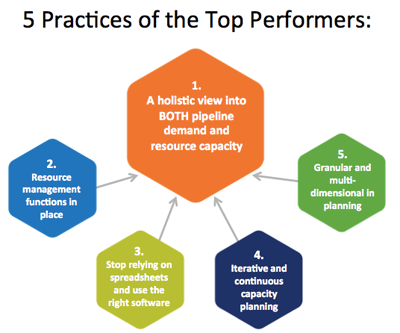
Based on The 2014 Resource Management and Capacity Planning Report
Some of you may be skeptical at the title of my blog post. Can the resource dilemma be solved and even mastered? You’re not alone if the norm at your organizations looks like this: resources are always overcommitted, no one ever says “no”, and you’ve become numb to project delays. If overcommitment is not the monkey on your back, it may be that resources are underutilized or applied to the wrong projects. The upshot is that few are confident that limited resources are aligned to the highest value work.
Before we become jaded, there is proof that this common and costly dilemma is solvable. Research shows that as organizations become more proficient in the distinct but highly interrelated disciplines of resource management and capacity planning, they can reduce the top pain points significantly to lessen related business risks and maximize the value of resources.
How Do We Know It’s Solvable?
The 2014 Resource Management and Capacity Planning Benchmark Report
I’m wildly excited to invite you to visit a new research website and related reports on the most comprehensive research conducted on this important topic. More than 480 resource leaders from around the world participated in an online study that was preceded by a qualitative phone interviews with several participants providing case studies from several markets.
Assessing Maturity: This year’s study assessed resource management and capacity planning maturity of organizations to analyze the differences between pain points, causes, and business risks. You can get the definitions for resource management and capacity planning and assess your organization’s maturity on the website.
Significant Reductions in Pain Points
Resource Management: As organizations move up in maturity, they are statistically less likely to experience the most common pain points. While overcommitting resources is the top resource management pain point for 77% of lower maturity organizations, it is 37% less likely to be an issue for higher maturity organizations. And, overcommitting resources is often a symptom of the other most common pain points.
Capacity Planning: Top performers are 53% more likely to have a holistic view into both pipeline demand and resource capacity than their lower maturity counterparts. As a result, when they are considering projects in the pipeline, they are less likely to overcommit and have higher visibility into whether they’ll have the resources to take on work when the time comes.
Business Risks of Inaction: When asked the business risks of not improving in resource management and capacity planning maturity, executives are concerned about loss of revenue (51%) and missed business opportunities (51%). Middle managers are concerned about project delays, project costs, and the inability to innovate fast enough. These are clearly related but there is work to do to shore up executive support to improve the processes and tools to manage these functions more effectively.

5 Essential Insights from the Top Performers
The highest maturity organizations have made great strides to overcome the most common pain points putting them into position to maximize the productivity of their limited resources.
Explore the findings interactively to see the pain points by maturity and also by organization type: Product Development, IT or EPMOs, Service-Centric companies to see how it measures up with your peers.
I want to hear from you. Where do you rank on the resource management and capacity planning maturity scale? What do you think about the research overall. Share or ask a question in the comment box below.




